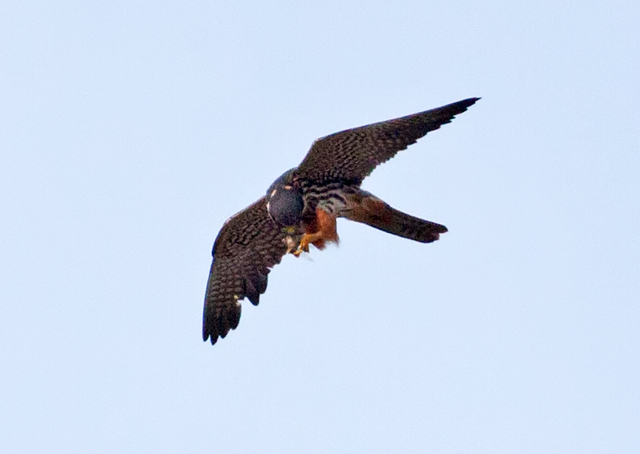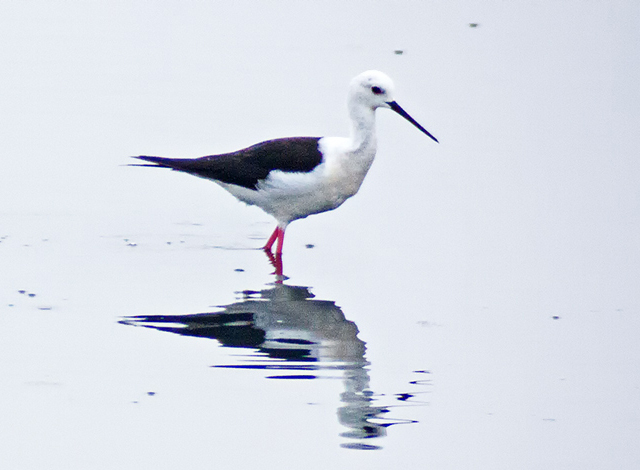 | E-mail to Birds Korea |
 | KWBS |
in the Region
 | The Oriental Bird Club |
 | BirdLife International (Asia) |
August
Typically hot and humid (with day maxima often around 30°C until at least mid-month), with occasional heavy rains and strong winds, associated either with southern typhoons or caused by the mix of humidity and heat.
Chinese Egrets become widespread along the west coast. Shorebirds (including a very small number of Spoon-billed Sandpiper) begin to build up at a few of the remaining best sites. Numbers tend to be rather lower than in spring, though Kentish Plover and Terek Sandpiper often number in the thousands in the southwest.
Parties of Black-naped Orioles, the appearance of returning leaf warblers (especially Eastern-crowned and Arctic Warblers) and small numbers of Brown Shrike and Yellow-rumped and Brown Flycatchers by mid-month also hint at the start of passerine migration, while Eurasian Hobby appear to be on the move by the month’s end. At the very end of August, the first migrant Pechora Pipit (most likely of the subspecies menzbieri) and early migrant buntings also appear on offshore islands. August national rarities include Common Ringed Plover, Sooty Tern, House Swift, Black Tern and Lesser Frigatebird. National firsts since 2000 have included Sooty Shearwater in 2002, and Aleutian Tern and Great Frigatebird in 2004.
(The following records are a compilation of our own sightings and records sent in by other observers. As well as being posted on the Birds Korea website(s), selected records are also forwarded to other Korean-language birding websites; records of threatened species are arranged and forwarded to Birdlife International and national authorities when appropriate; flag images and records are passed to bodies responsible for their coordination throughout the flyway; and all records sent to us are used to compile annual reports and to support the evolving understanding of the status of many of Korea’s birds.)
Nakdong, August 31
On Saturday morning, light to dark grey clouds covered the sky. A typhoon (Toraji) had passed the night before more quietly than expected. At Myeongji, 300+ Barn Swallow were at roost on some reeds, while hundreds more were in flight. This roosting flock included 4+ brown Martins (were they Pale or Sand?). From a distance, I was able to find and watch a few shorebirds. They included Mongolian Plover (5), Common Greenshank (9), Red-necked Stint (131), Wood Sandpiper (23), Sharp-tailed Sandpiper (3), Great Knot (30+), Whimbrel, Far Eastern Curlew (7), and Eurasian Curlew (2).
Straining to get good views, I decided to move on to Eulsukdo. I met up with members of the Nakdong Eco-school team, Ms Kim Bok Sun and Ms Park Jin Ju. Walking along a stretch of willow trees, we found a few juvenile and adult Grey-streaked Flycatchers hawking insects. We also found one adult Asian Brown Flycatcher and four Arctic Warbler sensu lato (JL). Other species observed were Common Kingfisher, Oriental Reed Warbler, and still many Far Eastern Cisticola.
On my way home, I couldn’t help but make one more stop at a favorite patch. At this spot, I often only find roosting Spot-billed Duck, Mandarin Duck (including juvenile), Common Greenshank, egrets and herons. So you can imagine how stoked I was when I found Black-tailed Godwit (5), Sharp-tailed Sandpiper (3), Wood Sandpiper (15), Black-winged Stilt (5) and Common Snipe (7) all within a few meters of my usual observation point.
Mokpo Namhang Urban Wetland, August 31
An hour long visit to the natural tidal-flat of the Mokpo Namhang Urban Wetland short before high tide showed a very interesting assemblage of shorebirds: 12 Black-tailed Godwit, 73 Common Greenshank, 13 Common Redshank, 10 Whimbrel, 8 Ruddy Turnstone, 3 Grey-tailed Tattler, 5 Terek Sandpiper, 1 Great Knot, 3 Dunlin, 1 Grey Plover, 12 Pacific Golden Plover, c. 150 Red-necked Stint, 5 Broad-billed Sandpiper and 1 Kentish Plover.
Non shorebirds were 21 Grey Heron, 19 Great Egret, 3 Little Egret which all moved with the rising tide to other areas of the site or on to fishing boats and platforms. A small flock of uncounted Treesparrows flew over.

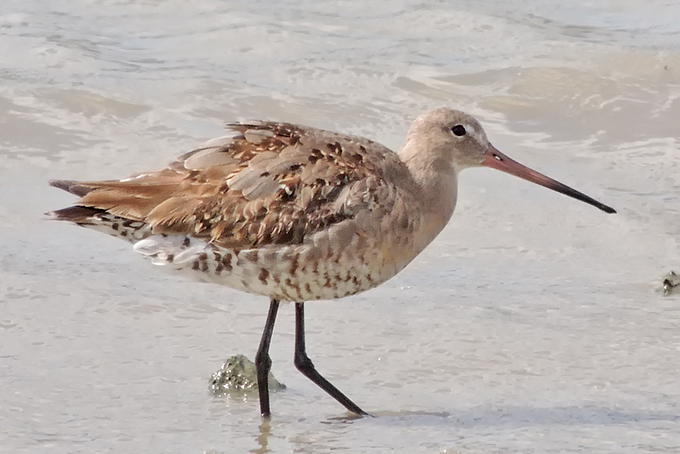

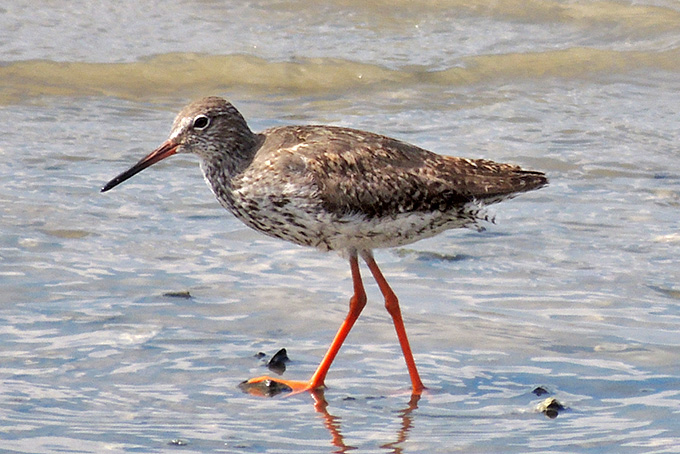


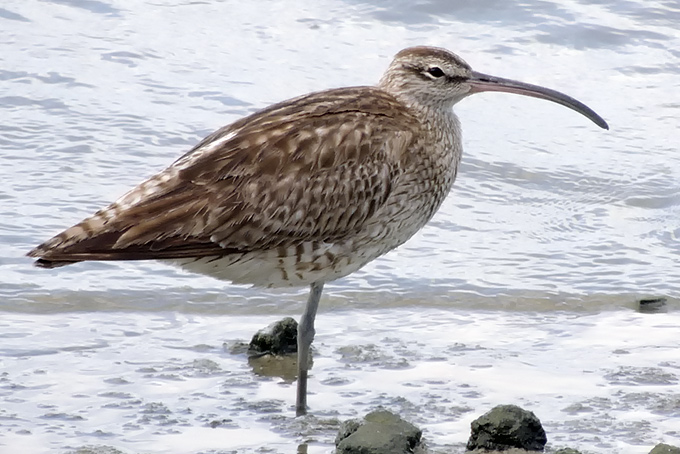



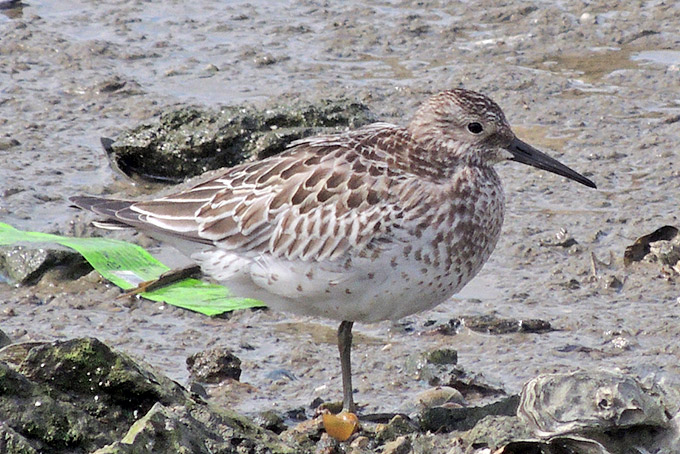


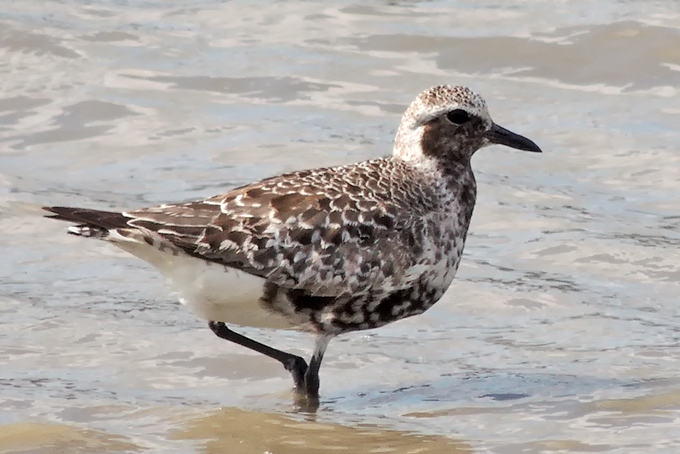

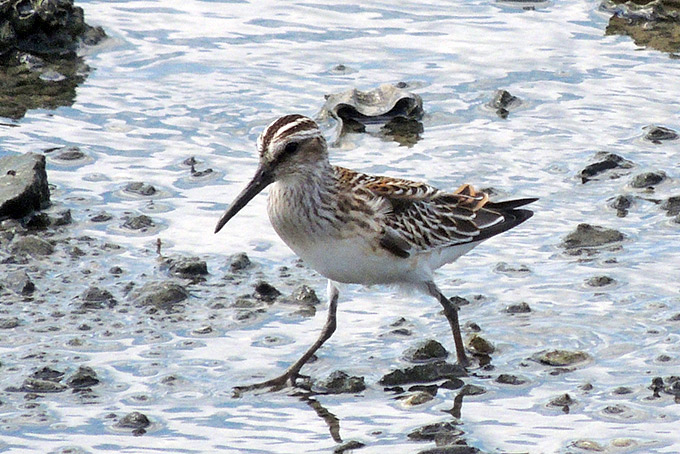
Heuksan Island, August 25
On Sunday morning, there was no sign of the swift flock, but there still several groups of Eastern Yellow Wagtail, both overhead and feeding. While most appeared to be nominate Eastern Yellows, one bird stood out. In the field its green and yellow head pattern (lacking the darker-than-crown ear-coverts of taivana) most closely resembled a flavissima or more likely a lutea Western Yellow Wagtail. A series of images were taken, and a couple of calls recorded. More will be posted on this wagtail at a later date.
Another species of interest was Light-vented Bulbul, with 25+ noted (including many juveniles). This species was only first recorded in the ROK a decade ago, but is becoming increasingly numerous as a breeder on some offshore islands. We also enjoyed good views of an ‘early’ Eurasian Wryneck and a pair of Daurian Starling. Other landbird highlights include a worn adult Black Woodpigeon, Oriental Dollarbird, Blue Rock Thrush, several juvenile Pale Thrush, a male Grey Thrush (HJM only), Grey-streaked Flycatcher, Asian Brown Flycatcher, single Yellow-rumped Flycatcher, 2+ Tiger Shrike, and a Brown Shrike (HJM only).
Shorebirds were well-represented too and included Pacific Golden Plover (5), Long-toed Stint (2), Wood Sandpiper, Common Sandpiper, Pin-tailed Snipe (perhaps 5+), Sanderling (9), Red-necked Stint, and Black-winged Stilt (4).
Special thanks to those who helped organize this trip, to all who joined, and especially to Dr. Nial Moores for his guiding. Hoping to have more trips like this with our members in the near future!

Heuksan Island, August 24
On Saturday morning, a group of Birds Koreans met to look at seabirds off Heuksan Island. It was relatively cool (24°C) with periods of rain, occasionally heavy (>50mm), and an increasing sea-swell (with swell height increasing from c. 1m to 3m at peak). Highlights of the day from the boat included 20-30 Swinhoe’s Storm Petrel, with some seen very close including one carrying a fish. We also had prolonged looks at Streaked Shearwater, brief views of small numbers of Red-necked Phalarope, about 9 Common Tern, and a distant view of one or two Flesh-footed Shearwater. We finished the day on land, birding close to the main town. There were good numbers of wagtails overhead, including a single flock of 160 Eastern Yellow Wagtail. The sky swarmed with feeding dragonflies and a flock of Pacific Swift (50+), joined by 3+White-throated Needletail and a Himalayan Swiftlet (a species which is scarcely recorded annually in the ROK).

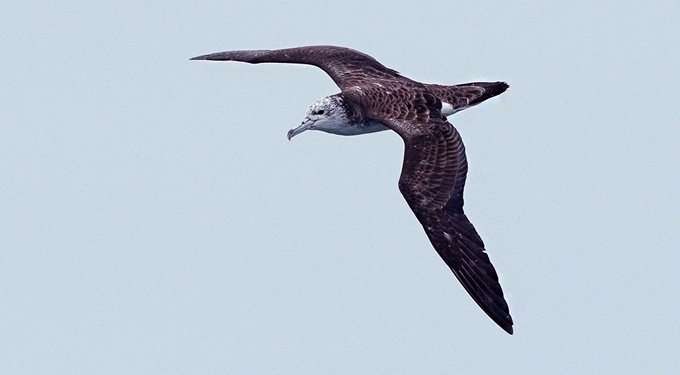
Mokpo Okam-dong, August 21
The stream at high tide had only few birds. 2 Great Egret, 1 Intermediate Egret, 3 Little Egret, 1 Striated Heron, 4 Grey-tailed Tattler, 1 Black-backed Wagtail, a short appearing Common Kingfisher as well as a few Black-tailed Gulls and Eurasian Tree Sparrow.
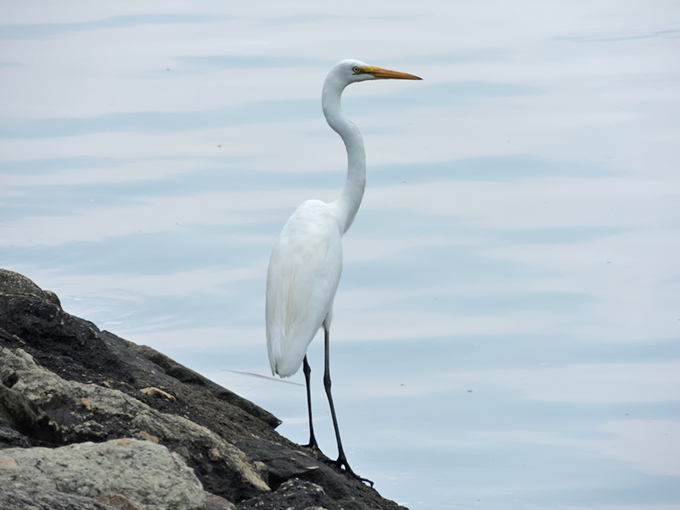



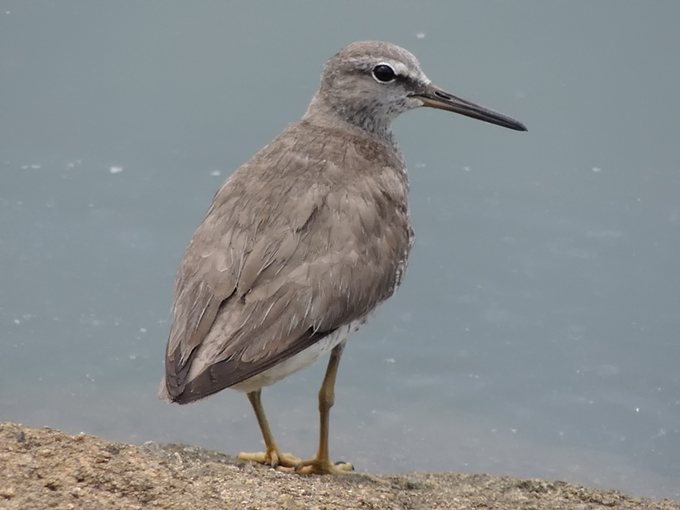



Songdo August 17 - 18
The heatwave continues into a third month of temperatures above 30 degrees and 80% humidity. At Songdo, where further chunks of habitat dissapear under construction with each new visit, dwindling birdlife is crowded into ever more enclosed and degraded corners of habitat. Another massive section of intertidal zone has been concreted over, but it appears developers have finally halted the destruction just short of Sorae -at Gojan- where about 6% of the former mudflat area is now suddenly declared as "protected" on enviro-friendly signboards.
I checked out Aham-do and the nearby golf course on the 17th, and Gojan and the lagoon on the 18th. Striking was the paltry number of juveniles compared to previous years. Species observed were:
Common Pheasant Phasianus colchicus. One on the old golf course.
Mallard Anas platyrhynchos. Fourteen on the lagoon.
Eastern Spot-billed Duck Anas zonorhyncha. Numerous.
Garganey Anas querquedula. One eclipse on the lagoon. Featuring e.g. white spot at base of bill.
Eurasian Teal Anas crecca. One on the lagoon is about two weeks earlier than usual.
Little Grebe Tachybaptus ruficollis. Six on the lagoon, including 2 juveniles.
Black-faced Spoonbill Platalea minor. Nineteen at Aham-do, 26 at Gojan, and 14 on the lagoon (which included at least five juveniles).
Grey Heron Ardea cinerea.
Great Egret Ardea alba.
Intermediate Egret Egretta intermedia. One on the lagoon.
Little Egret Egretta garzetta.
Chinese Egret Egretta eulophotes. One at Aham-do, two on the lagoon (occasionally they venture onto coastal freshwater), and one at Gojan.
Great Cormorant Phalacrocorax carbo. Someone has cut down their roosting trees.
Eurasian Hobby Falco subbuteo. One eating dragonflies at Aham-do.
Peregrine Falcon Falco peregrinus. Two juveniles, one at Gojan and another on the lagoon, tested their rather inept hunting skills and roused flocks of shorebirds in the process, which eluded harrasment by gradually flying higher than the falcons, dropping back to earth only once danger had passed.
Common Moorhen Gallinula chloropus. One on the lagoon.
Eurasian Coot Fulica atra. One on the lagoon.
Far Eastern Oystercatcher Haematopus (ostralegus) osculans. Three at Gojan.
Black-winged Stilt Himantopus himantopus. A flock of 29 (including 4 young of the year) on the lagoon is apparently the second-highest concentration so far recorded in Korea. The juveniles are undoubtedly locally raised, from two nests noted here in June.
Grey Plover Pluvialis squatarola. 50+ at Aham-do, 315 at Gojan.
Mongolian Plover Charadrius m. mongolus. Eighteen at Gojan, mostly still in red-breasted breeding colouration.
Pin-tailed Snipe Gallinago stenura. One in ditch at Songdo Golf course. ID based on smallish size, brief glimpse of underwing, silent flushing and mid-flight squeak.
Black-tailed Godwit Limosa limosa. Two on the mud at Gojan, 170 on the lagoon.
Bar-tailed Godwit Limosa lapponica. One at Aham-do, 520 at Gojan.
Whimbrel Numenius phaeopus. Fifteen at Aham-do, 10 at Gojan.
Eurasian Curlew Numenius arquata. Some 60+ at Gojan.
Far Eastern Curlew Numenius madagascariensis. Two at Aham-do, 210 at Gojan.
Spotted Redshank Tringa erythropus. One at Gojan. A scarce sight on mudflat.
Common Redshank Tringa totanus. Six on the mudflat at Aham-do and two at Gojan.
Marsh Sandpiper Tringa stagnatilis. Two on the lagoon.
Common Greenshank Tringa nebularia. c.150 at Aham-do, another 450 at Gojan and c.40 on the lagoon.
Wood Sandpiper Tringa glareola. 20+ on the lagoon.
Grey-tailed Tattler Heteroscelus brevipes. Two at Aham-do.
Terek Sandpiper Xenus cinereus. 20+ at Aham-do, at least 350 at Gojan.
Common Sandpiper Actitis hypoleucos. Twelve or so on the lagoon.
Ruddy Turnstone Arenaria interpres. Nine at Gojan.
Great Knot Calidris tenuirostris. Twelve at Gojan.
Long-toed Stint Calidris subminuta. One on the lagoon.
Dunlin Calidris alpina. Only two noticed at Gojan.
Saunders's Gull Chroicocephalus saundersi. Twenty-six at Gojan included only one juvenile.
Black-tailed Gull Larus crassirostris.
Mongolian Gull Larus mongolicus. Two at Aham-do and 12 between the lagoon and Gojan, including one juvenile.
Oriental Turtle Dove Streptopelia orientalis.
Eurasian Magpie Pica pica.
Eastern Great Tit Parus minor.
Eurasian Tree Sparrow Passer montanus.
On Aham-do where among the butterflies, many Asian Comma.
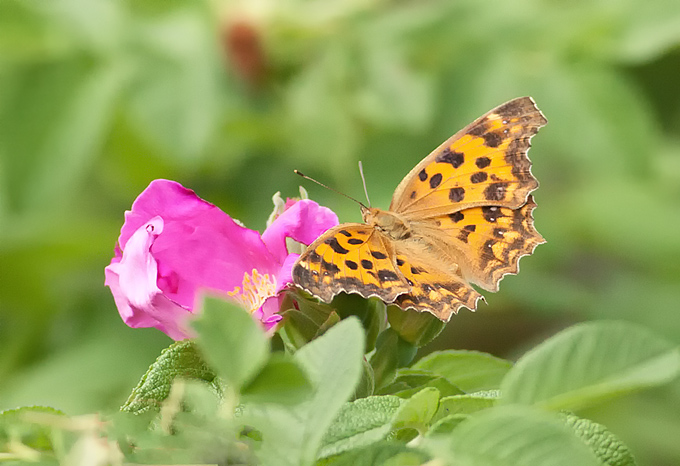 Asian Comma Polygonia-c-aureum, © Tim EdelstenBird News highlights from “Team Spoony: the Movie”
Asian Comma Polygonia-c-aureum, © Tim EdelstenBird News highlights from “Team Spoony: the Movie”
Various West Coast Sites, August 10 - 13As part of Birds Korea work on a mini-documentary on Spoon-billed Sandpiper and tidal-flat conservation, a team of Birds Koreans (Paul Mossine, Ha Jung-Moon, Jason Loghry, Lee Jung-Kyu and Nial Moores) visited several West Coast Sites. In sweltering heat (reaching between 35C and 37C each day) and in intensely bright conditions, we filmed landscapes and conducted interviews, and counted shorebirds at several sites. Within Saemangeum, the Geum Estuary, Seosan and Song Do in Incheon special birding highlights included three Common Shelduck (presumably birds that had over-summered?); Black-faced Spoonbills and Chinese Egrets at two sites; an adult male Oriental Plover (NM only); 30+ Greater Sand Plover; an astonishing 23-30+ White-faced Plover (only three or so previous records nationally of this intriguing taxon!); a single adult Nordmann’s Greenshank; and (best of all!) approximately eight Spoon-billed Sandpiper (all individually identified on plumage).
 White-faced Plover Charadrius alexandrinus dealbatus, © Nial Moores
White-faced Plover Charadrius alexandrinus dealbatus, © Nial Moores White-faced Plover Charadrius alexandrinus dealbatus left, right (?), Spoon-billed Sandpiper Eurynorhynchus pygmeus center,
White-faced Plover Charadrius alexandrinus dealbatus left, right (?), Spoon-billed Sandpiper Eurynorhynchus pygmeus center,
© Nial Moores Breeding-plumaged Spoon-billed Sandpiper Eurynorhynchus pygmeus, © Nial MooresBird News from Ha Jung-Mun for “Team Spoony: the Movie”
Breeding-plumaged Spoon-billed Sandpiper Eurynorhynchus pygmeus, © Nial MooresBird News from Ha Jung-Mun for “Team Spoony: the Movie”
Various West Coast Sites, August 10 - 12As a part of taking footage for the mini-documentary about Spoon-billed Sandpiper and mudflat conservation, we could take a chance to look over several mudflats on the western coasts.
I have heard that the migration of shorebirds are earlier than last years, quite good numbers of birds were passing the coastal area as expected.
The total number of counted shorebirds were over 20,000, and almost all general species were seen on the mudflat.
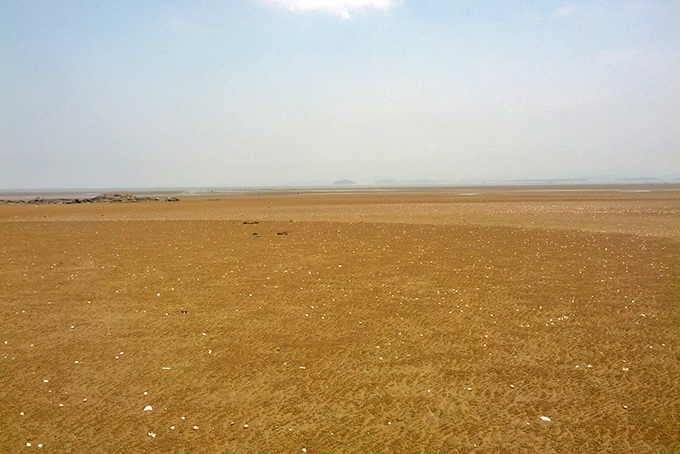 Mudflat at Low Tide, © Ha Jung-Mun
Mudflat at Low Tide, © Ha Jung-Mun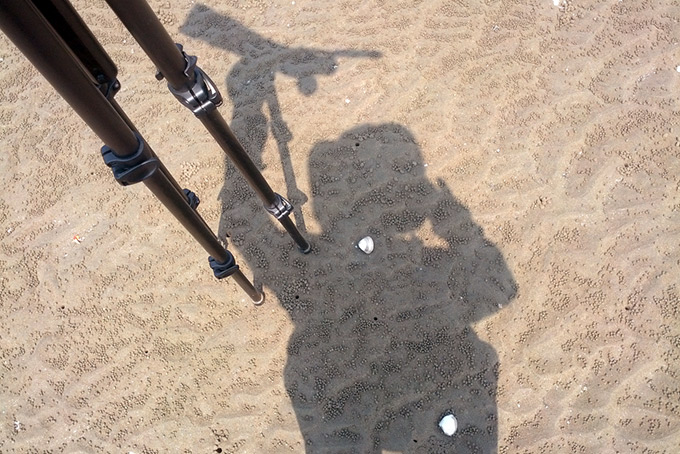 On the Mudflat at Low Tide, © Ha Jung-Mun
On the Mudflat at Low Tide, © Ha Jung-MunSighted Species:
Common Shelduck Tadorna tadorna.
Eastern Spot-billed Duck Anas zonorhyncha.
Black-faced Spoonbill Platalea minor. The 9 individuals flew in the direction of Geum Estuary.
Black-crowned Night Heron Nycticorax nycticorax.
Grey Heron Ardea cinerea.
Great Egret Ardea alba.
Little Egret Egretta garzetta.
Chinese Egret Egretta eulophotes. 5 including juveniles on the mudflat.
Great Cormorant Phalacrocorax carbo.
Common Kestrel Falco tinnunculus.
Peregrine Falcon Falco peregrinus.
Far Eastern Oystercatcher Haematopus ostralegus. About 1100 individuals.
Pacific Golden Plover Pluvialis fulva. Only heard, not seen.
Grey Plover Pluvialis squatarola.
Kentish Plover Charadrius alexandrinus. Over 990 individuals.
White-faced Plover Charadrius alexandrinus dealbatus. Though it is considered as a rare migratory species, over 22 individuals among the Kentish flock sighted at this time. It is suspected that this is a atypical case or just not reported by lack of information about this species.
Mongolian Plover Charadrius mongolus. Over 1400 individuals.
Greater Sand Plover Charadrius leschenaultii. Over 30 individuals.
Pin-tailed Snipe Gallinago stenura.
Black-tailed Godwit Limosa limosa.
Bar-tailed Godwit Limosa lapponica. About 1500 individuals.
Whimbrel Numenius phaeopus.
Eurasian Curlew Numenius arquata. Suggested that about 300 individuals were observed.
Far Eastern Curlew Numenius madagascariensis. About 500 individuals.
Common Redshank Tringa totanus.
Marsh Sandpiper Tringa stagnatilis.
Common Greenshank Tringa nebularia. About 100 individuals.
 Common Greenshank Tringa nebularia, © Ha Jung-Mun
Common Greenshank Tringa nebularia, © Ha Jung-MunNordmann's Greenshank Tringa guttifer. Just one individual sighted among the Common Greenshank flock. The white underwing pattern was indentified by Dr. Nial Moores.
Wood Sandpiper Tringa glareola. Was only heard.
Grey-tailed Tattler Tringa brevipes.
Terek Sandpiper Xenus cinereus. About 1500 individuals.
Common Sandpiper Actitis hypoleucos.
Ruddy Turnstone Arenaria interpres. Suggested that about 30 individuals were observed.
Great Knot Calidris tenuirostris. The dominant one between the species counted at this time, 5500-6000 individuals were observed.
Red Knot Calidris canutus. More than 23 individuals were sighted mixed with Great Knot flocks.
Sanderling Calidris alba. Suggested about 300 individuals.
Red-necked Stint Calidris ruficollis. About 1000 individuals were sighted.
Sharp-tailed Sandpiper Calidris acuminata. At least 4 birds observed.
Dunlin Calidris alpina. Suggested over 1000 individuals.
Spoon-billed Sandpiper Eurynorhynchus pygmeus. From the discussion about different features seen by diffrent observers, we concluded that 8 individuals were sighted on the mudflat.
 Spoon-billed Sandpiper Eurynorhynchus pygmeus (center), © Ha Jung-Mun
Spoon-billed Sandpiper Eurynorhynchus pygmeus (center), © Ha Jung-MunBroad-billed Sandpiper Limicola falcinellus. About 590 individuals.
Saunders's Gull Chroicocephalus saundersi.
Black-tailed Gull Larus crassirostris.
Mongolian Gull Larus mongolicus.
 Mongolian Gull Larus mongolicus, © Ha Jung-Mun
Mongolian Gull Larus mongolicus, © Ha Jung-MunLittle Tern Sternula albifrons.
Oriental Turtle Dove Streptopelia orientalis.
Tiger Shrike Lanius tigrinus.
Eurasian Magpie Pica pica.
Barn Swallow Hirundo rustica.
Korean Bush Warbler Horornis borealis. When trying to find the Styan's, the typical call type of this species 'cchat! cchat!' was heard.
Styan's Grasshopper Warbler Locustella pleskei. We could hear several individual's song from the small area, suspected 4 individuals by the directions and distances of songs. They were extremely shy, only alarm calls and songs could be heard.
White-cheeked Starling Spodiopsar cineraceus. Calls from flying birds.
Tree Sparrow Passer montanus.
White Wagtail Motacilla alba. Only heard.
Bird News from Tim Edelsten
Yongjeong Island survey, July 29 - August 4Summer is very quiet, birdwise, in Korea. Personally I view it as an enjoyable challenge to find stuff, but this also involves surviving the sweltering heat and humidity. My watch of "airport island" began with a walk around Yongyudo on July 29th. By attempting digiscoping rather than using my 400mm lens I missed several cracking photo chances unfortunately. I will be prepared next time! On July 31st, I took a look at the Western reservoir and adjacent natural wetland (which is only a small remnant of what was formerly). At Mt. Begeun on August 1st photography was tricky in the dark shady forest. Some pretty lepidoptera there, including an Indian Owlet Moth, and an ancient Keyaki tree. Birds are still to be heard singing, although mostly only briefly and at dusk. On August 3rd I checked out the S.E. shorebird roost and coastal road, viewing the southern mudflat area. Sadly the actual roost site- where birds are at their most vulnerable- is subject to increasing disturbance by recreational fishermen. Lastly I took a short walk along the Seonyebawi coastal road on the 4th. I recorded the following species:
Common Pheasant Phasianus colchicus.
Falcated Duck Anas falcata. Three in eclipse plumage. This is apparently the first July record for Korea.
Mallard Anas platyrhynchos. Very scarce in summer. One on the wetland near the western reservoir on the 31st.
Eastern Spot-billed Duck Anas zonorhyncha.
Tufted Duck Aythya fuligula. Five on the reservoir on the 31st. There is perhaps only one previous July record.
Little Grebe Tachybaptus ruficollis. Fourteen on the reservoir included juveniles.
Black-faced Spoonbill Platalea minor. One at Yongyudo mudflat, three on the saltpans, 74 at the SE roost, 5 at Seonyebawi.
Black-crowned Night Heron Nycticorax nycticorax. Two at Yongyu pond.
Striated Heron Butorides striata. Quite common all over the island. Juveniles have emerged.
Eastern Cattle Egret Bubulcus coromandus.
Grey Heron Ardea cinerea.
Great Egret Ardea alba modesta.
Intermediate Egret Egretta intermedia. Six on the mudflat at Yongyudo, with distinctive "tilting forward" hunting technique.
Little Egret Egretta garzetta.
Chinese Egret Egretta eulophotes. Two at Yongyudo, ten or more along the south coastal mudflat.
Great Cormorant Phalacrocorax carbo. Up to 30 on the reservoir, including several juveniles.
Temminck's Cormorant Phalacrocorax capillatus. One immature at the reservoir, identified by very extensive bright white underparts, including on neck and face.
Chinese Sparrowhawk Accipiter soloensis. A male at Begeunsan.
Common Kestrel Falco tinnunculus. A pair with two chicks practising flying near the western reservoir.
Eurasian Hobby Falco subbuteo. One made an optimistic pass at a flock of swallows.
Eurasian Coot Fulica atra. A pair with three chicks on the wetland near the reservoir.
Grey Plover Pluvialis squatarola. 60+ on the southern mudflat, including one leg-flagged (Yellow, right tibia).
Little Ringed Plover Charadrius dubius. An adult and a juvenile on the saltpan.
Lesser Sand Plover Charadrius mongolus. 15-20 on the southern mudflat.
Swinhoe's Snipe Gallinago megala. One seen well at Yongyudo on the 29th is apparently the first July record of any gallinago Snipe in Korea.
Flushed silently at close quarters from a ricefield verge, it appeared distinctly larger than common and showed a finely vermiculated greyish underwing. After a somewhat fluttery, low escape flight of perhaps eight or nine yards, it dropped into thick grass, when the momentarily splayed tail showed no "pins" but a chestnut centre with whitish edges.
Seconds later it darted out onto the road to stare at me for a few seconds- before disappearing once more - when somewhat bulky build and uniformly-patterned coverts gave an almost woodcock-like impression; underparts were distinctly dull, with dark breast and heavily marked chest-sides and flanks.Bar-tailed Godwit Limosa lapponica. Up to 300 on the southern mudflat.
Whimbrel Numenius phaeopus. 100+ on the southern mudflat, 29 at Seonyebawi.
Eurasian Curlew Numenius arquata. C. 30 on the southern mudflat.
Far Eastern Curlew Numenius madagascariensis. 500+ on the southern mudflat.
Common Redshank Tringa totanus. One at the saltpans, one on the south coastal mudflat.
Common Greenshank Tringa nebularia. 1000+ at the SE roost area, 40 on the saltpan.
Wood Sandpiper Tringa glareola One standing sentry, while a nervous flock of six fed at the saltpans.
Grey-tailed Tattler Heteroscelus brevipes. Two at the saltpans, 3 in the SE roost area, and a flock of 32 at Seonyebawi.
Terek Sandpiper Xenus cinereus. 1200+ on the southern mudflat area.
Common Sandpiper Actitis hypoleucos. Three at the saltpans.
Ruddy Turnstone Arenaria interpres. Two on the southern mudflat.
Great Knot Calidris tenuirostris. One at the SE roost.
Red Knot Calidris canutus. Five on the southern mudflat.
Red-necked Stint Calidris ruficollis. One at the saltpans, 35 on the southern mudflat.
Dunlin Calidris alpina. 40 on the southern mudflat.
Black-headed Gull Chroicocephalus ridibundus. Very scarce in summer. One at the reservoir on the 31st.
Saunders's Gull Chroicocephalus saundersi. Ten adults and 7 juveniles at the SE roost.
Black-tailed Gull Larus crassirostris. 3000+ at the SE roost, 1000 at Yongyu bay.
Mongolian Gull Larus mongolicus. One at the SE roost area. Panting to keep cool in the midday sun.
Little Tern Sternula albifrons. 25 or so diving, viewed from the south coast road.
Oriental Turtle Dove Streptopelia orientalis.
Oriental Dollarbird Eurystomus orientalis. Pair apparently hunting the abundant newly-emerged dragonflies with high, roving flight.
Common Kingfisher Alcedo atthis. Two at Yongyudo.
Great Spotted Woodpecker Dendrocopos major. One at Yongyudo, another at Begeunsan. There seems to be no other woodpecker species on the island.
Black-naped Oriole Oriolus chinensis.
Eurasian Magpie Pica pica.
Carrion Crow Corvus corone. A pair, usually in the lowland farm field area.
Large-billed Crow Corvus macrorhynchos. Several around the mountaintop. This species seems to prefer wooded hillsides.
Varied Tit Poecile varius. A pair at Begeunsan.
Eastern Great Tit Parus minor.
Eurasian/ "Far Eastern" Skylark Alauda arvensis. One near the reservoir showing territorial behaviour.
Brown-eared Bulbul Hypsipetes amaurotis.
Barn Swallow Hirundo rustica. Drinking flock of c. 15 at the saltpans, 2 at the reservoir.
Oriental Reed Warbler Acrocephalus orientalis. Two at the reservoir, including one delightfully singing in the late evening.
Zitting Cisticola Cisticola juncidis. One calling near the western reservoir.
Vinous-throated Parrotbill Sinosuthera webbiana. Flock at Yongyudo.
White's Thrush Zoothera aurea. One heard in the evening at Begeunsan.
Grey-backed Thrush Turdus hortulorum. One singing in the spinney at Yongyudo. Three to five mellow notes repeated at frequent intervals, e.g. "trrp-trrp-tee-who".
Stejneger's Stonechat Saxicola stejnegeri. Eight or nine skulking in reeds and grass near the reservoir on July 31st are early migrants.
Blue-and-White Flycatcher Cyanoptila cyanomelana intermedia. A male singing beautifully -and wing-snapping- in a glade near the spring.
Eurasian Tree Sparrow Passer montanus. Now in post-breeding flocks.
Grey Wagtail Motacilla cinerea. One singing near the western reservoir on the 31st. Sibbilant watery trills floating over on the breeze.
White Wagtail Motacilla alba leucopsis. A family at the reservoir and group 'creche" of 9 along the south coastal road.
Meadow Bunting Emberiza cioides castaneiceps. A rather worn out male seen in song near the reservoir. "Chu-chu-whee,chup-chup".
Yellow-throated Bunting Emberiza elegans. Two males singing in late afternoon at Begeunsan and one at Yongyu.
 Surviving remnant of natural wetland, west Yongjeong Island, © Tim Edelsten
Surviving remnant of natural wetland, west Yongjeong Island, © Tim Edelsten Indian Owlet Moth Spirama retorta, © Tim Edelsten
Indian Owlet Moth Spirama retorta, © Tim Edelsten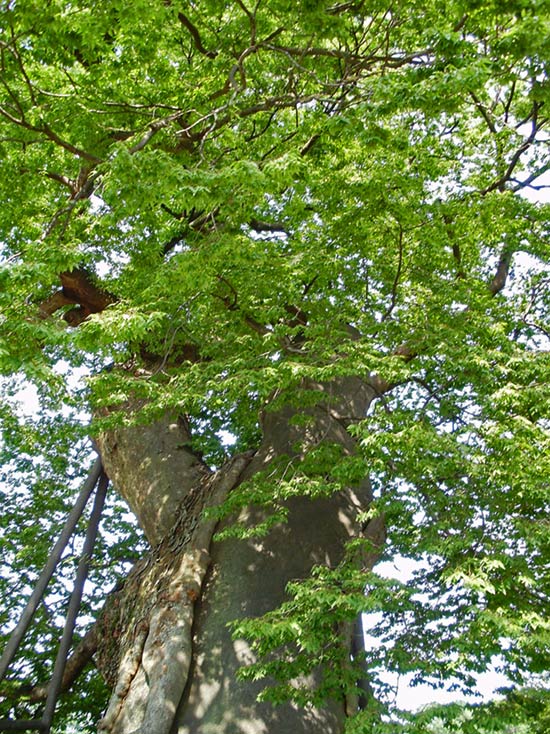 1300-yr old Keyaki Zelkova serrata, © Tim Edelsten
1300-yr old Keyaki Zelkova serrata, © Tim Edelsten Black-faced Spoonbill Platalea minor, © Tim Edelsten
Black-faced Spoonbill Platalea minor, © Tim Edelsten Blue-and-white Flycatcher Cyanoptila cyanomelana intermedia, © Tim Edelsten
Blue-and-white Flycatcher Cyanoptila cyanomelana intermedia, © Tim Edelsten Meadow Bunting Emberiza cioides castaneiceps, © Tim Edelsten
Meadow Bunting Emberiza cioides castaneiceps, © Tim Edelsten Yellow-throated Bunting Emberiza elegans, © Tim EdelstenCopyright 2002 - present http://www.birdskorea.org all rights reserved
Yellow-throated Bunting Emberiza elegans, © Tim EdelstenCopyright 2002 - present http://www.birdskorea.org all rights reserved
Birds Korea 1108 Ho, 3 Dong, Samick Tower Apt., 148-22, Namcheon-Dong, Su-Young-Gu
Busan, 618-762 Republic of Korea
 Common Redshank Tringa totanus, © Ha Jung-Mun
Common Redshank Tringa totanus, © Ha Jung-Mun
